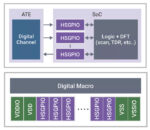The trend is clear, AI and HPC is moving to chiplet-based, or heterogenous design to achieve the highest levels of performance, while traditional monolithic system-on-chip (SoC) designs struggle to scale. What is also clear is the road to this new design style is not a smooth one. There are many challenges to overcome. Some are … Read More
Design-Technology Co-Optimization (DTCO) Accelerates Market Readiness of Angstrom-Scale Process Technologies
Design-Technology Co-Optimization (DTCO) has been a foundational concept in semiconductor engineering for years. So, when Synopsys referenced DTCO in their April 2025 press release about enabling Angstrom-scale chip designs on Intel’s 18A and 18A-P process technologies, it may have sounded familiar—almost expected. … Read More
WEBINAR: PCIe 7.0? Understanding Why Now Is the Time to Transition
PCIe is familiar to legions of PC users as a high-performance enabler for expansion slots, especially GPU-based graphics cards and M.2 SSDs. It connects higher-bandwidth networking adapters and niche applications like system expansion chassis in server environments. Each PCIe specification generation has provided a leap… Read More
The Road to Innovation with Synopsys 224G PHY IP From Silicon to Scale: Synopsys 224G PHY Enables Next Gen Scaling Networks
The explosive growth of large language models (LLMs) has created substantial new requirements for chip-to-chip interconnects. These very large models are trained in high-performance data centers. Multiple accelerators need to work seamlessly to make all this possible as the bandwidth between accelerators directly impacts… Read More
Scaling AI Infrastructure with Next-Gen Interconnects
At the recent IPSoC Conference in Silicon Valley, Aparna Tarde gave a talk on the importance of Next-Gen Interconnects to scale AI infrastructure. Aparna is a Sr. Technical Product Manager at Synopsys. A synthesis of the salient points from her talk follows.
The rapid advancement of artificial intelligence (AI) is fundamentally… Read More
The Growing Importance of PVT Monitoring for Silicon Lifecycle Management
In an era defined by complex chip architectures, ever-shrinking technology nodes and very demanding applications, Silicon Lifecycle Management (SLM) has become a foundational strategy for optimizing performance, reliability, and efficiency across the lifespan of a semiconductor device. Central to effective SLM are Process,… Read More
Achieving Seamless 1.6 Tbps Interoperability for High BW HPC AI/ML SoCs: A Technical Webinar with Samtec and Synopsys
HPC Bandwidth Explosion and 1.6T Ecosystem Interop Need
The exponential growth in data bandwidth requirements driven by HPC systems, AI, and ML applications has set the stage for an ever-increasing need for 1.6Tbps Ethernet. As data centers strive to manage vast data transfers with maximum efficiency, the urgency for interoperability… Read More
Balancing the Demands of OTP for Advanced Nodes with Synopsys IP
One-time programmable (OTP) non-volatile memory has been around for a long time. Compared to other non-volatile memory technologies OTP has a smaller footprint and does not require additional manufacturing steps, making it a popular choice to store items such as boot code and encryption keys. While this sounds simple, the growth… Read More
Synopsys Executive Forum: Driving Silicon and Systems Engineering Innovation
The annual SNUG (Synopsys Users Group) conference, now in its 35th year, once again brought together key stakeholders to showcase accomplishments, discuss challenges, and explore opportunities within the semiconductor and electronics industry. With approximately 2,500 attendees, SNUG 2025 served as a dynamic hub for collaboration… Read More
A Synopsys Webinar Detailing IP Requirements for Advanced AI Chips
Generative AI is dramatically changing the compute power that must be delivered by advanced designs. This demand has risen by more than 10,000 times in the past five to six years. This increased demand has impacted the entire SoC design flow. We are now faced with going beyond 1 trillion transistors per chip, and systems now consist… Read More











